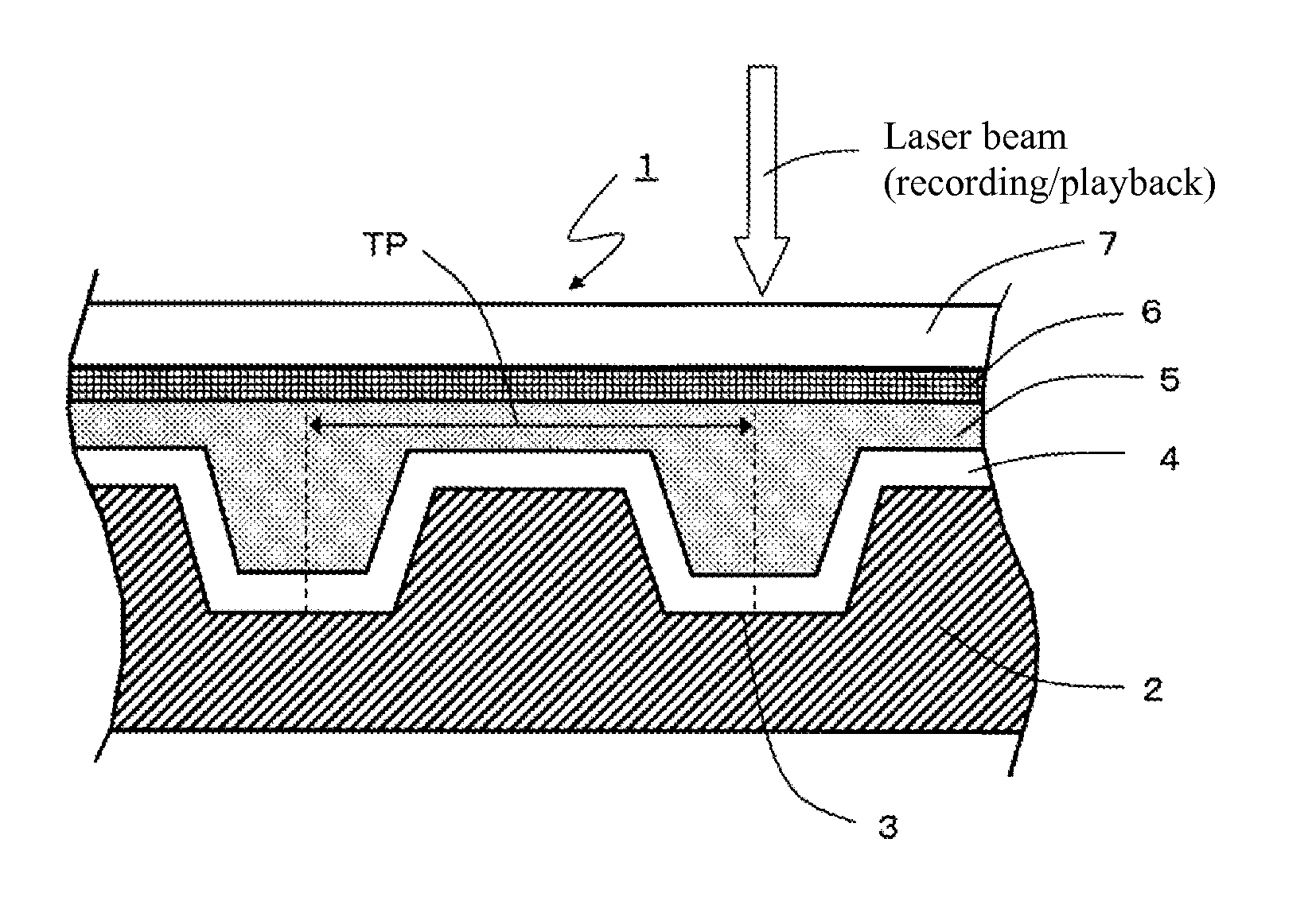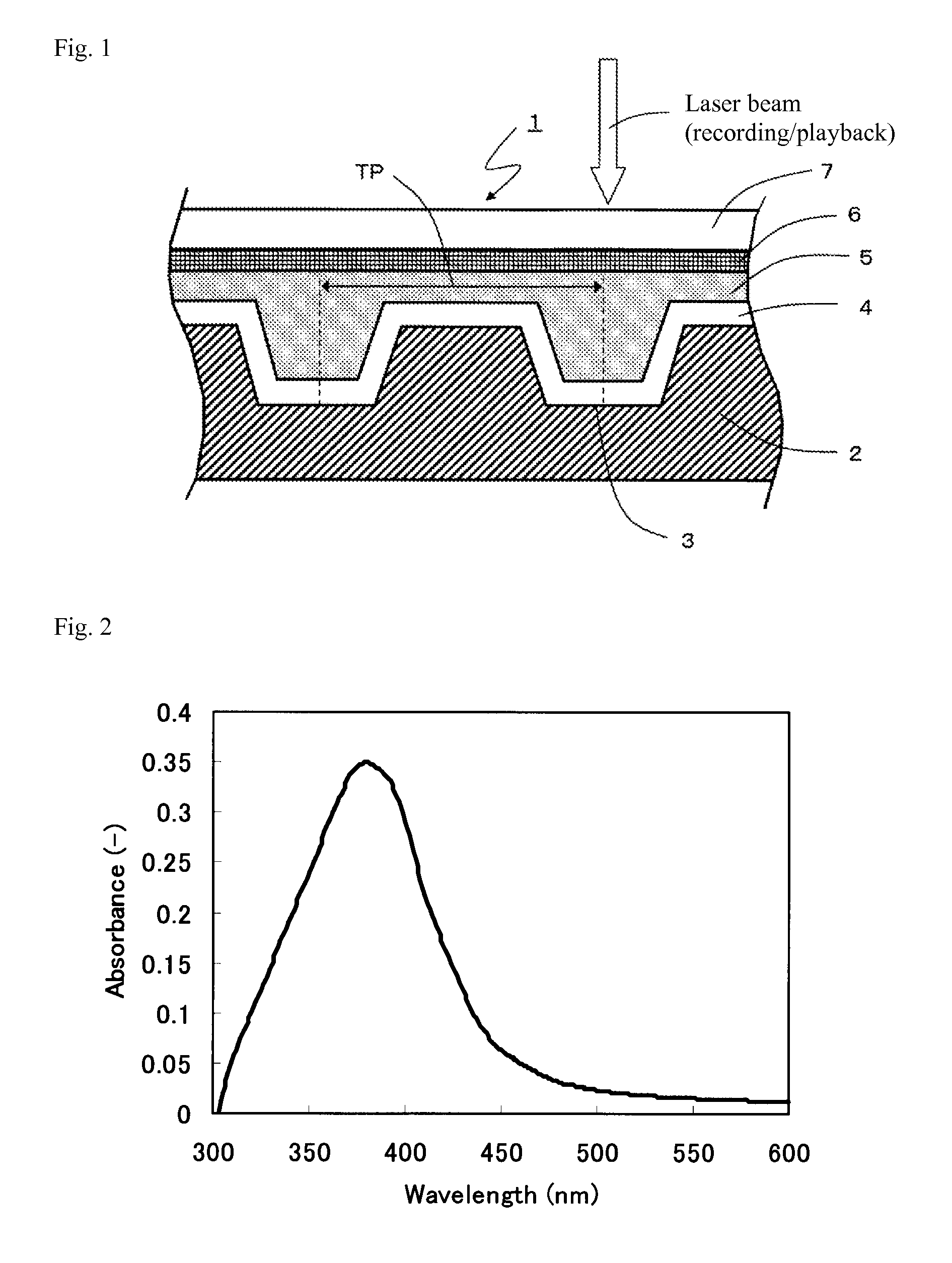Coloring matter for optical information recording medium and optical information recording medium
- Summary
- Abstract
- Description
- Claims
- Application Information
AI Technical Summary
Benefits of technology
Problems solved by technology
Method used
Image
Examples
example 1
[0029]A disc-shaped polycarbonate substrate of 120 mm in outer diameter and 1.1 mm in thickness, having a through hole at the center as well as a guide groove of 0.32 μm in track pitch, 180 nm in groove width and 32 nm in groove depth, was created by injection molding. On the side of this substrate on which the guide groove was formed, Ag alloy was applied by sputtering to form a reflective layer of 60 nm in thickness. Thereafter, a dye solution prepared by dissolving in a TFP (tetrafluoropropanol) solvent an organic dye expressed by the chemical formula in (Chemical Formula 3) was applied by the spin-coat method under film forming conditions that would give an OD of 0.25, after which the substrate was dried for 30 minutes at 80° C. to form a recording layer.
[0030]Next, a transparent protective layer of ZnS—SiO2 was formed by sputtering to a thickness of 20 nm. Then, a UV-curable resin whose modulus of elasticity would become 1700 MPa at 25° C. after being cured was applied by the s...
example 2
[0033]An optical information recording medium was obtained in the same manner as in Example 1, except that an organic dye expressed by the chemical formula in (Chemical Formula 4) was used for the recording layer, instead of the organic dye in Example 1. This dye conforming to (Chemical Formula 4) had the absorption spectrum shown in FIG. 4. Since the maximum absorption wavelength (λmax) of this dye was 375 nm, the absorbance was measured with light of 375 nm in wavelength to derive the OD. Because the OD at which the DC jitter became the smallest was 0.32, the recording layer was formed under film forming conditions that would give an OD of 0.32.
[0034]The sample optical information recording medium thus obtained was evaluated for its playback characteristics by recording data using a recording / playback apparatus (ODU-1000 by Pulstec Industrial Co., Ltd.) in the same manner as in Example 1. The eye pattern was also observed at a laser power of 0.35 mW. The optical information record...
example 3
[0035]An optical information recording medium was obtained in the same manner as in Example 1, except that an organic dye expressed by the chemical formula in (Chemical Formula 5) was used for the recording layer, instead of the organic dye in Example 1. This dye conforming to (Chemical Formula 5) had the absorption spectrum shown in FIG. 6. Since the maximum absorption wavelength (λmax) of this dye was 409 nm, the absorbance was measured with light of 409 nm in wavelength to derive the OD. Because the OD at which the DC jitter became the smallest was 0.25, the recording layer was formed under film forming conditions that would give an OD of 0.25.
[0036]The sample optical information recording medium thus obtained was evaluated for its playback characteristics by recording data using a recording / playback apparatus (ODU-1000 by Pulstec Industrial Co., Ltd.) in the same manner as in Example 1. The eye pattern was also observed at a laser power of 0.35 mW. The optical information record...
PUM
 Login to View More
Login to View More Abstract
Description
Claims
Application Information
 Login to View More
Login to View More - R&D
- Intellectual Property
- Life Sciences
- Materials
- Tech Scout
- Unparalleled Data Quality
- Higher Quality Content
- 60% Fewer Hallucinations
Browse by: Latest US Patents, China's latest patents, Technical Efficacy Thesaurus, Application Domain, Technology Topic, Popular Technical Reports.
© 2025 PatSnap. All rights reserved.Legal|Privacy policy|Modern Slavery Act Transparency Statement|Sitemap|About US| Contact US: help@patsnap.com



